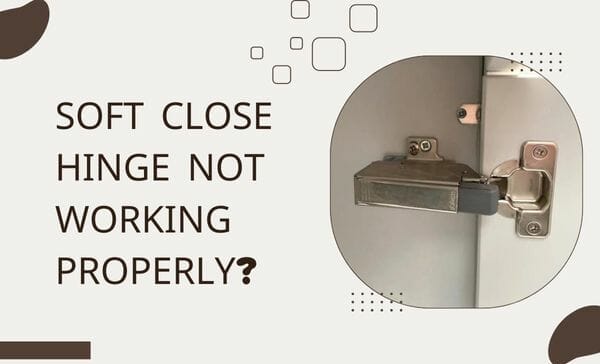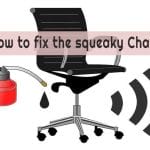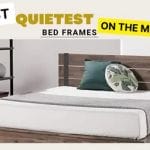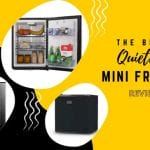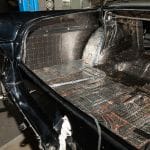As an affiliate, we may receive commissions from purchases made via our links at no additional cost to you.
Often overlooked and forgotten, soft close hinges are a useful piece of equipment for any home. This means no more slamming cabinets and doors – great!. Suddenly Soft close hinge not working properly, what can you do? It’s not so great.
A loose screw is the most likely cause of a non-functioning soft close hinge. As a result, the hinges can become weaker or displaced. The issue can be easily fixed by identifying the problem screw and tightening it.
It is our pleasure to recommend products to you as an affiliate. Just so you know, In this links on this page, we may receive a commission or other compensation. We really appreciate it if you use our links!
Do Soft Close Hinges Wear Out?
Through constant use, it is not uncommon for soft-closing hinges to begin to degrade over time as they are continuously used. When you open and close the cabinets regularly, wear and tear can occur as a result of routine wear and tear.
As soon as it has worn out, you will notice the door slamming every time you close it, which means the soft close is no longer working, and the door will start slamming when you close it.
Why Is My Soft Close Hinge Not Working Properly – Slamming?
A squeaking or slamming sound when you close your cabinet door is an indication that your hinges are no longer functioning properly. This is a sign that your cabinet door hinges not working properly. Because, Hydraulic buffers can get stuck, or mechanisms can wear out.
You should probably replace them if this has happened to you. This is a great product. They are available in a variety of sizes and quantities. Soft close hinges from Ravinte soft close hinges.
Why Won’t My Soft Close Cabinet Close Door ?
You need to fix the cabinet door if it does not close properly, is sagging, or shows a gap near the hinge.
Poor adjustment of the hinges and doors is usually the cause of a soft-close hinge that doesn’t close the cabinet properly. In some cases, cabinet doors overlap with the doors next to them and become misaligned. As a result, the hinges may not be able to close properly.
What Kind of Soft Close Cabinet Hinge Do You Need?
Let’s begin by figuring out what hinge you’ll need.
In the first step, Understanding how your cabinet is constructed.
Frameless: Cabinets with frameless sides are commonly called European cabinets since they extend to the front. This style of cabinet is pictured above.
Face frame: This type of cabinet is characterized by a frame on the front of the cabinet, in the same way that a picture frame is used on a wall. You can see a picture of this type of cabinet in the next section, where you will notice that there is a wood frame covering the sides of the cabinet.
CONCEALED HINGES FOR FACE FRAME CABINETS
Face frame cabinets have frames attached to the fronts of their sides, as you may know.
For face frames, there are five general types of hinges:
- Clip on hinges
- Partial overlay
- Full overlay
- Face mount full overlay
- Inset face frame
Which one do you need? I recommend following this rule of thumb since the list is all about overlays:
- Using clip on or partial overlay hinges will allow you to see the face frame
- Compact full overlays or face mounts can be used if you want to cover the face frame as much as possible.
An exception to this rule is the inset frame hinge, which is mostly used in furniture. As a result of their complexity, as well as the precision of the door and frame construction, I would consider these hinges to be the best.
FRAMELESS SOFT CLOSING CABINET HINGES
You’ll have about as much difficulty choosing the right hinge if your cabinets are frameless.
The three basic types of frameless hinges are as follows:
- Inset
- Partial overlay
- Full overlay
It is simple to determine which is right for your project:
- If you plan to see the cabinet frame edge, then your decision will depend on your opening angle (110 or 170-degree is most common).
- If there will be no other door adjacent to the cabinet end, use a full overlay.
- If there will be another door adjacent to the cabinet, use a partial or “half-overlay” on the cabinet side.
7 most common issues with soft close hinges and how to avoid them
Wouldn’t it be great if I could simply buy my hinges and install them myself?
There is no doubt that these hinges can be installed with a little planning, time and patience, but everyone can read up on some lessons learned before getting started… There is no big deal about drilling a 1/2 inch deep hole in a cabinet door when you consider that a hinge is a hinge.
1. Mistakes in Overlay Ordering
Initially, you might find overlay to be a difficult terminology to understand if you’re installing cabinet hinges for the first time. There is no measurement for “full overlay.”.
Here are a few tips:
Cabinets with face frames: Build your face frames and then lay out the door widths with a pencil and ruler. Your hinges should then be matched to the “overlay” on the hinge side. There are a variety of hinge overlays that I use on my projects, and I use them often.
For frameless cabinets, there are three options: inset (no overlay hinge), full overlay when there is no adjacent door, and half overlay when the cabinet sits against another cabinet.
2. Hinges and roll-out shelving are not planned together
The issue can even be stumbled upon by experienced cabinetmakers. Almost all new cabinets use soft close hardware, though it’s not limited to soft close hardware.
Roll-out shelving: what makes it special? First of all, it’s important to install the shelving or drawer as low as possible on the door or as close as possible in order to maximize the available cabinet space. In most cases, that’s where the hinge will be located.
What is the solution? The sliding shelf can be attached to the cabinet by attaching a 1/2′′ wood strip that protrudes from each side, rather than worrying about hinge placement. Basically, you’ll need to create a narrow opening of 1″ to install the sliding shelves.
3. Too Deep a Drilling For The Hinge Cup

Make sure you use a concealed hinge jig and predrill on a test piece before drilling this one.
4. The purchase of frameless hinges for face frame cabinets
Occasionally, it happens.
There are times when products are mis-labeled or the website is not clear. Make sure you double check the hinge style against your cabinet construction.
5. Incorrectly positioning the hinge cup
- Installing a cabinet hinge incorrectly is easily one of the most frustrating issues.
- This means installing it in one of three locations:
- Face frame cabinets, where it will overlap the bottom or top rails (preventing installation)
- Unsightly gaps are caused by setting the hinge cup too close to the door edge
- Binding can also be caused by setting the hinge cup too far from the edge of the door.
6. Damaging the door During Installation
It’s getting specific now, isn’t it?
Since I’ve installed thousands of soft close cabinet doors, I now install the top hinge first. Whenever I drop a screw, misplace a hinge, or do something else that causes me to break my focus from the door, I follow this approach:
Makes it easier to balance cabinets while installing screws by allowing them to hang suspended from a top hinge temporarily.
7. Door not adjusted
It is necessary to adjust all cabinet doors after installation. Standard hinges simply need to be adjusted for the door to be level and aligned with adjacent doors, but a soft close door needs to be adjusted as well:
The dampers can be turned on/off to achieve the right closing speed (or the damper piston can be adjusted on the Probico)
Ensure that locking screws are installed to firmly secure hinges to the cabinet. If this is not done, hinges may work loose over time.
Would you like a little more insight into the differences between soft close cabinet hinges?
You might wonder why it’s not worth it to grab the cheapest hinge for your project? What is hinge damper recovery time?
Maybe you’re building a new project and are concerned about drilling a rather large hole in your cabinet door? Let me answer your questions and help you choose the right option.
Soft close Cabinet door hinges with features
Let’s first look at what makes one hinge perform better in this review:
- Verification by the vendor that the hinge will last tens of thousands of cycles according to ANSI/BHMA
- For fast door opening and closing, damper size and recovery time are important
- Adjustability
- The reputation of the brand and how long it has been in business
- Adjustable closing force on/off switches
How To Fix A Faulty Hinge?
One of the main reasons your hinges aren’t working properly is an improper position of the adjustment screws.
The hinges will not work properly if the screws are not in place. Look for the adjustment screws between the top and bottom hinges. Once the hinges are proper alignment, the cabinet door will operate correctly.
It’s also common for soft-close hinges to malfunction when the screws are loose. When the screws are loose, the door can hang down and the hinge may separate from the door.
When tightening screws and maintaining hinge placement, use the right screwdriver. This is usually best accomplished with a Phillips flathead screwdriver.
Can soft close hinges be adjusted for tension?
There are ways to adjust the speed and tension of the soft-close hinges on your cabinets. You can adjust the hinges by pressing the lever with pressure and tension at the same time.
In order to properly adjust the hinge, you must turn the lever clockwise until it points towards the ceiling. There should be a 10-millimeter gap between the hinge and tab.
For recalibration to prevent door from slamming, rotate the adjustment lever at an angle of 90 degrees clockwise. The hinge should now be pointing at the floor.
Once you’ve found the perfect adjustment, tension, and speed for the cabinet door, you can keep experimenting with the hinge.
It Is Not Possible To Close Soft-Close Hinges All The Way
When soft-close hinges are adjusted too strongly, the cabinet may not shut properly, resulting in the door staying open. In other words, the mechanism that prevents slamming becomes so robust that it prevents the door from closing completely.
When the mechanism is too weak, the door will slam shut and the hinges will not serve their purpose. This can happen if the hinges are incorrectly installed.
If your cabinets can’t close properly, you can fix them by finding the resistance adjuster. Usually a plus and minus symbol appears on a small screw. You will also need a screwdriver that fits this screw.
In this step, you will adjust the resistance based on the problem. It is important to experiment with different levels of resistance until the door is completely fixed if it does not shut properly. The door needs to be repeatedly opened and closed until it is completely fixed.
The best way to fix a squeaky hinge?
A squeaky hinge is a warning sign that the hinge is not working properly. It also deteriorates the look of your cabinets. Soft-closing hinges are designed to close cabinet doors smoothly and quietly.
After applying a generous amount of lubricant, close and open the door to facilitate free movement. You can also use grease or oil to reduce friction.
Unless the squeaks are completely gone, you may need to re-lubricate the hinges every few days until they aren’t stiff anymore.
The Best Way To Clean A Dirty Hinge?
A simple solution to this is to submerge the hinge in hot water and laundry detergent for some time to melt away the accumulated gunk.
You should always apply some lubricant after cleaning the hinges that prevent them from rusting or stiffening again.
What Is The Difference Between Soft Close and Self Closing Hinges?
Soft-close hinges and self-close hinges are the two main types of cabinet hinges.
A self-closing cabinet hinge has a spring that pulls and closes the cabinet door at a certain point. Meanwhile, a soft-closing hinge has stopped working a hydraulic buffer to keep the door from slamming shut.
It is possible to find hinges in different styles and finishes to suit any cabinet or cupboard in a home or office. They are used in perfect kitchen cabinet door, bedrooms, bathrooms, and other places in homes and offices.
Traditional vs European Hinges
Would it be helpful if you could tell me what kind of soft close hinges your cabinets have? There are usually two flat plates on traditional hinges. There may be partial or full visibility of the hinges. It is common to loosen the screws on traditional hinges and slide the plates to adjust them.
The European hinges, on the other hand, are completely concealed within the cabinet door. Hinge screws and door position can be adjusted using a special barrel. The adjustable screws may need to be exposed by removing the barrel cover. They are usually found on the door-connected portion of the hinge.
Read More: The best soft close cabinet hinges of 2024
Final words
In most cases, a loose screw or a misaligned cabinet door is the culprit, so you should be able to find the problem and fix it in no time. Soft-close hinges are usually very simple to fix because they are usually caused by a loose screw or a misaligned cabinet door.
You should call in a technician if you’ve tried all of the above-mentioned solutions and your soft-close hinges still don’t seem to work. In order to prevent further damage to the hinges, you should avoid further tampering with them.
